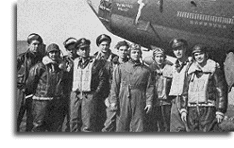Author Archive
In 1941, the New York Herald Tribune published a letter from a woman who was tired of sitting at home worrying about the war. “If I were only a man, there would be a place for me,” she wrote. Many women shared similar feelings of frustration, eager to play an active role in the conflict, but held back because by law and tradition. But as the war escalated, many countries found they could not afford to exclude half of their adult populations and doors began to open for women. They went to work in factories. Capital cities became overrun with female office workers. Nurses joined the front line troops. And many women were allowed to fly.
The Soviet Union, which already had a tradition of women in combat, was the first nation to use women pilots. After suffering huge battle casualties in 1941, the government ordered all women without children who were not already engaged in war work to join the military. There were three all-woman regiments: fighter, bomber, and night bomber. Other women flew with male regiments and pilot Valentina Grizodubova was even the commander of a 300-man, long-range bomber squadron. With the exception of Turkey’s Sabiha Gokcen, the Soviet women were the only women who flew in combat. German pilots were often surprised suddenly to be circled by Russian planes and hear female voices shouting to each other. Lily Litvyak became an ace, downing 12 German planes until she was shot down in 1943. Twenty-three women were given the “Hero of the Soviet Union” medal. When Marina Raskova, who had helped organize the female pilots, was killed in combat in 1943, the government held its first state funeral of World War II, entombing her ashes in the wall of the Kremlin as a sign of gratitude for all Soviet women who flew.
Fascist ideology dictated that a women’s role in society was as a mother and frowned upon women working in any capacity. A few German women did find ways to work, some in jobs such as ferrying and test pilots. Melitta Schiller was awarded the Iron Cross for conducting 1,500 test dives of new dive bombers. And Hitler favorite Hanna Reitsch, a record-breaking glider and test pilot before the war, flew every Luftwaffe plane and helicopter. Denied permission to organize a women’s flight squadron, she organized a suicide squadron that would use V-1 rockets modified with seats to hold pilots to attack British industrial centers. The program was eventually dropped. In the final days of the war, she flew a Luftwaffe general through Soviet artillery fire and fighters to land on a road in central Berlin and meet with Hitler just days before he killed himself.
Although Canada and Australia did not allow women to fly military planes, Great Britain used women to ferry planes as part of the Air Transport Auxiliary. Organized by Pauline Gower, eight women began ferrying single-engine Tiger Moth trainers around England in 1940. Despite their unpopularity among the male pilots, the women proved themselves capable pilots. The variety of planes increased and more women joined the program–not only from England, but also from the Commonwealth nations and from Poland, Chile, and the United States. Ferrying planes in England was not without dangers, and pilots encountered barrage balloons, artillery, anti-aircraft batteries, Royal Air Force training flights, radio silence, and German planes. The women were expected to fly anything assigned to them, even if they had to consult the Ferry Pilots’ Notes to learn the basic information on an aircraft before taking off. The ATA women survived all their obstacles admirably, with an accident rate equal to their male counterparts, earning the respect of their countrymen.
In the United States, with the support of First Lady Eleanor Roosevelt, who called them a “weapon waiting to be used,” record-breaking pilot Jacqueline Cochran tried to use her influence to form a woman’s squadron, but seeing that it was hopeless, she took a group of women pilots to England to fly with the British ATA. During her absence, the U.S. Army organized the Women’s Auxiliary Army Corps in 1941 (WAAC) (changed to the Women’s Army Corps (WACs) when the group was militarized in 1943). The WACs were assigned to non-flying aviation positions such as Link trainer instructors, radio operators, mechanics, photo interpreters and parachute riggers. The Navy established the WAVES (Women Appointed for Volunteer Emergency Service) in 1942 to perform the same assignments as the WACs, as well as become control tower operators, a controversial decision since detractors worried that women could not handle the multiple tasks required. But the women excelled and the only problem was that the WAVES uniform skirt was too snug for climbing the ladders into the towers.
The U.S. Air Transport Command had been investigating, through pilot Nancy Love, using women to ferry planes from the factories to stateside military bases. Although U.S. Army Air Force Chief of Staff Henry “Hap” Arnold had promised Jacqueline Cochran and the White House that Cochran would have command of any women’s unit, that was not to pass. Military politics led to the announcement on September 10, 1942 of the Women’s Auxiliary Ferrying Squadron (WAFS), under the command of Love. The first WAFS group arrived, after an intensive screening process, at New Castle Air Base in October. Although civilians, they began flying military planes in the contiguous United States.
As a peace offering to the angry Cochran, Arnold organized the Women’s Flying Training Detachment (WFTD) to train pilots.
The WFTD training school was at Avenger Field in Sweetwater, Texas, where 1,074 women were taught to fly “the Army way” while living the military lifestyle with uniforms, drills, regulations, and morning reveille. Although never officially made members of the military, the women still behaved as if they had been.
In August 1943 the two women’s groups were merged, under Cochran’s command and renamed the Women’s Air Force Service Pilots (WASPs). The WASPs accumulated an amazing record. They flew every airplane in the USAAF’s inventory, including half of all pursuit planes delivered during the war. When male pilots were afraid to fly the new B-29 Superfortress because of mechanical difficulties experienced during testing, two WASPs took one, Ladybird, on a tour of air bases to show the men how safe the plane was. And the women’s duties increased beyond ferrying. They towed targets for aerial gunnery practice, simulated strafing, served as flight instructors, and ran check flights for recently repaired aircraft. And Ann Baumgartner worked as a test pilot at Wright Field where she became the first woman to fly the YP-59 jet. Thirty-eight WASPs were killed performing their duties. In total, the female pilots logged 60 million miles flying their planes.
By the end of 1944 it was apparent the war in Europe would end soon. Male pilots, wanting to avoid being sent to the Pacific, lobbied hard for the duties the WASPs were performing. It was announced that on December 20, 1944, the WASPs would be deactivated. Cochran lobbied for a one-day militarization, which would at least give her women veteran status and access to GI Bill benefits, but she was denied.
Hap Arnold called the program a success, saying, “We will not again look upon a woman flying as an experiment.” They had proved themselves, but there was still no place for them. The women were crestfallen. Some volunteered to work without pay. One unit received letters from an airline only to find offers for stewardess jobs. Like all women who had kept the homefront running during the war, when the men returned home, they were expected to return to their traditional roles as housewives. Many, like Nancy Love, did. Others held out hope for flying futures, but these hopes were dashed when the establishment of the independent U.S. Air Force in 1948 brought only non-flying positions for women. The WASPs slipped into obscurity. In 1977 the air force announced that “for the first time, the Air Force is allowing women to fly its airplanes.” The WASPs found each other again, and with the help of former ferrying pilot Senator Barry Goldwater fought for, and in November 1977, received military recognition and veteran status. Their efforts were finally recognized. But although they could be interned at Arlington National Cemetery, WASPs did not begin to receive military honors until June 2002, when Irene Englund became the first WASP thus recognized.
Throughout World War II, women contributed to the war effort in many ways, earning the respect of society and laying the foundations for the women’s movement. As a group of male Russian pilots said to their combat partners: “Even if we were to place at your feet all the flowers of the earth they would not be big enough tribute to your valor.”
Early in World War II, the United States 8th Air Force decided to use its heavy bombers in daytime attacks against occupied Europe. The British predicted horrible losses during daylight raids. It was not suprising that the first bomber crew to complete 25 missions would be regarded as heroes. The crew of the B-17 “Memphis Belle” was the first to complete a combat tour. Between November 7, 1942, and May 17, 1943, the crew flew missions ranging from 4 to almost 10 hours in duration. For these missions Capt. Robert K. Morgan and his crew were awarded the Air Medal with three Oak Leaf Clusters and the Distinguished Flying Cross. The Memphis Belle and its crew were then returned to the United States on a morale-building tour of aircraft plants.

http://www.nizkor.org/hweb/imt/tgmwc/ offers a 22 volume transcript of Nuremberg trials.
Here is a summary of what each chapter contains:
- Vol. 1 The opening statements, indictment, etc.
- Vol. 2 Indictment (Continued)
- Vol. 3 Includes testimony of Otto Ohlendorf and Dieter Wisliceny, with respect to the policy to exterminate the Jews. December 17, 1945 to January 4, 1946
- Vol. 4 Criminality of groups & organizations, persecution of the Church, Individual responsibility of the defendents
- Vol. 5 Economic looting, Individual responsibility of the defendants, Oral evidence relating to the camps. January 21 through February 1, 1946
- Vol. 6, covering the period from 2nd February, 1946, to 13th February, 1946
- Vol. 7, covering the period from 14 February to 26 February.
- Vol. 8, covering the period from 27 February to 11 March.
- Vol. 9, covering the period from 12 March to 22 March.
- Vol. 10, covering the period from 23 March to 3 April. (Includes the testimony regarding the case against von Ribbentrop)
- Vol. 11, covering the period from 4 April to 15 April. (Includes the testimony of Auschwitz Commandant Rudolf Höss)
- Vol. 12, covering the period from 16 April to 1 May, 1946. (Includes testimony of Rosenberg, Frick, Frank and Schacht.)
- Vol. 13, covering the period from 2 May to 13 May. (Schacht, Vocke, Gisevius, Funk, Hayler, Lammers, Neubacher, Doenitz, Wagner, the Laconia)
- Vol. 14, covering the period from 14 May to 24 May, 1946. (Raeder, Wagner, Dënitz, Goth, Hessler, the Laconia, Funk, Puhl, Toms)
- Vol. 15, covering the period from 27 May to 6 June, 1946. (Schirach, Saukel, Jodl)
- Vol. 16, covering the period from 7 June to 19 June, 1946 (Jodl, Brandenfels, Buechs, Seyss-Inquart, Papen, Speer)
- Vol. 17, covering the period from 20 June to 1 July, 1946 (Speer, Neurath, Fritzsche, Bormann)
- Vol. 18, covering the period from 2 July to 15 July, 1946 (Katyn, Neurath, Bormann, Goering, Hess, Rippentrop, Keitel, Kaltenbrunner, Rosenberg, Frank, Frick, Streicher, Funk, Schacht, Doenitz)
- Vol. 19, covering the period from 16 July to 27 July, 1946 (Concluding speeches by Defence; Donitz, Raeder, Schirach, Sauckel, Jodl, Seyss-Inquart, Bormann, Papen, Speer, Neurath, Fritzsche, Hess; Concluding speeches by Prosecution)
- Vol. 20 covering the period from 29 July to 8 August, 1946 (Concluding speeches by Prosecution, Arguments by Counsel – SA, Defense case on Indicted Organizations, the Reich Cabinet and the SS)
- Vol. 21 Covering the period from 9 August to 21 August, 1946 (SS (concluded), Gestapo, General Staff, High Command, SA, Funk (Supplimented), Defense documents re Gestapo, SD, Reich Cabinet, SS)
- Vol. 22 Covering the period from 22 August to 31 August, 1946.
- Judgment
 Production 1908-1927
Production 1908-1927
Predecessor Ford Model S
Successor Ford Model A
Body style sedan, coupe, pickup truck
Engine 177 in³ (2.9 L) 4 cylinder motor, 20 hp
Transmission Rear wheel drive, planetary gear, 2 speed
Fuel capacity 10 gallons
Designer Henry Ford, Childe Harold Wills, Joseph A. Galamb and Eugene Farkas
The Ford Model T (colloquially known as the Tin Lizzie and the Flivver) was an automobile produced by Henry Ford’s Ford Motor Company from 1908 through 1927. The model T set 1908 as the historic year that the automobile came into popular usage. It is generally regarded as the first affordable automobile, the car which “put America on wheels”; this was due to some of Ford’s innovations, including assembly line production instead of individual hand crafting, as well as the concept of paying the workers a wage proportionate to the cost of the car, so that they would provide a ready made market. (Ford also attempted a ‘buy on time’ program to aid sales, resembling that of the German Kdf-Wagen [the forerunner of the Volkswagen Beetle]. Ford’s plan was not a success, either.) The first production Model T was built on September 27, 1908, at the Piquette Plant in Detroit, Michigan.
 1752 By tying a key onto a kite string during a storm, Ben Franklin , proved that static electricity and lightning were the same. His correct understanding of the nature of electricity paved the way for the future.
1752 By tying a key onto a kite string during a storm, Ben Franklin , proved that static electricity and lightning were the same. His correct understanding of the nature of electricity paved the way for the future.
1800 First electric battery invented by Alessandro Volta. The “volt” is named in his honor.
1808 Humphry Davy invented the first effective “arc lamp.” The arc lamp was a piece of carbon that glowed when attached to a battery by wires.
1820 Separate experiments by Hans Christian Oersted, A.M. Ampere, and D.F.G. Arago confirmed the relationship between electricity and magnetism. Read the rest of this entry »
